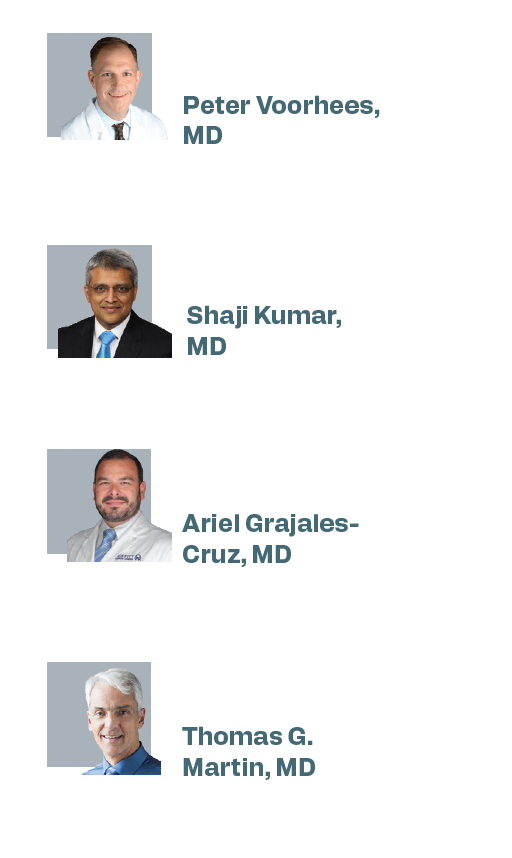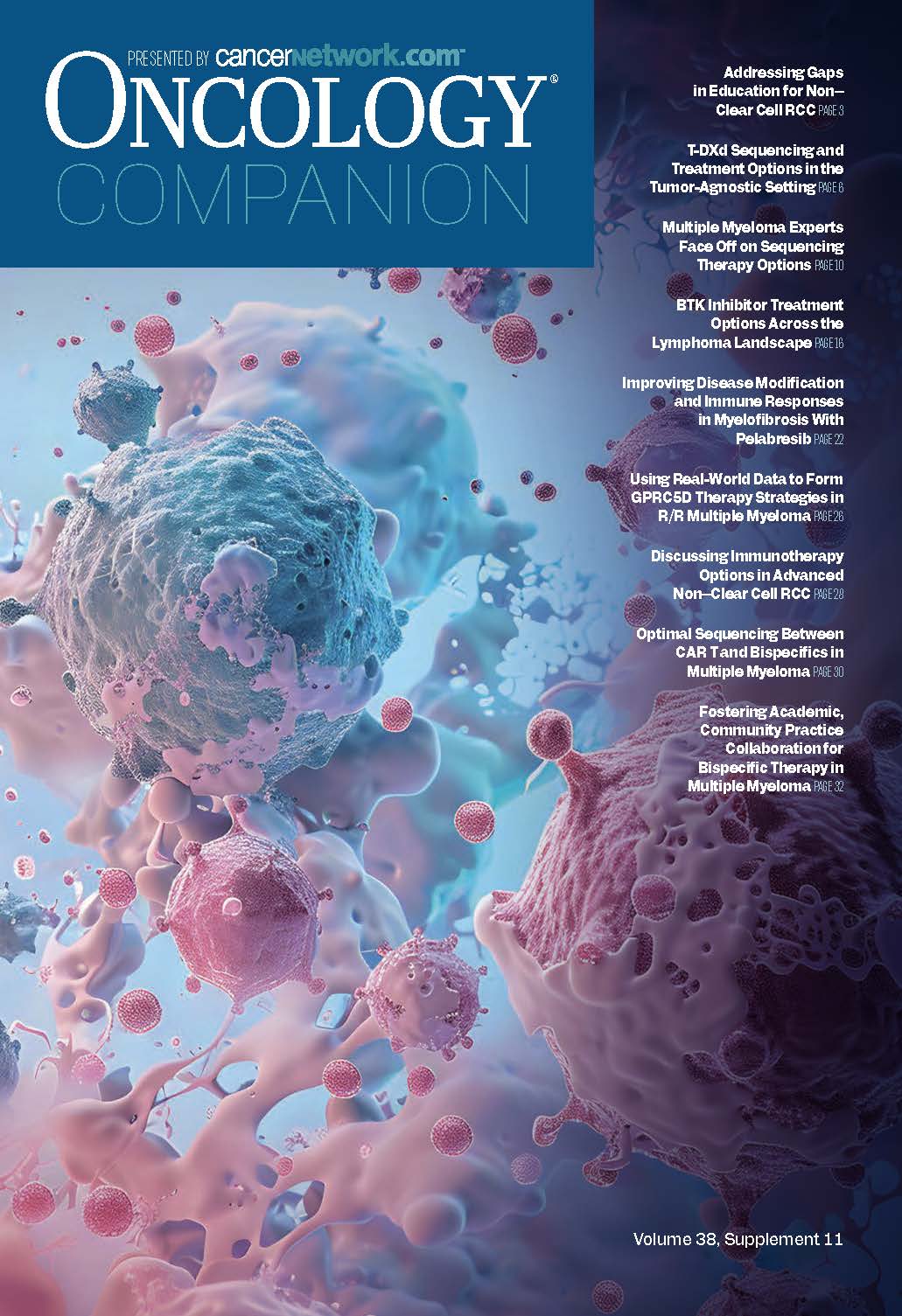Optimal Sequencing Between CAR T and Bispecifics in Multiple Myeloma
The use of CAR T-cell therapy and other sequencing options were discussed for patients with multiple myeloma.
Meet the experts

A recent Training Academy discussed the use of chimeric antigen receptor (CAR) T-cell therapy and other sequencing options for patients with multiple myeloma. Additionally, the phase 3 CARTITUDE-4 trial (NCT04181827) was discussed, and the efficacy and safety outcomes showed a positive trend with CAR T-cell therapy.
CARTITUDE-4 Trial
- Assessed ciltacabtagene autoleucel (cilta-cel, Carvykti) or physician’s choice standard of care (SOC) in patients with lenalidomide (Revlimid)–refractory relapsed/refractory
multiple myeloma. - Efficacy:
- The median follow-up was 15.9 months.
- Median progression-free survival (PFS) was not reached in the cilta-cel group vs 11.8 months in the SOC group (HR, 0.26; 95% CI, 0.18-0.38; P < .001).
- At 12 months, the PFS rate was 75.9% (95% CI, 69.4%-81.1%) vs 48.6% (95% CI, 41.5%-55.3%).
- The overall response rate was 84.6% vs 67.3%, complete response or better was 73.1% vs 21.8%, and 60.6% vs 15.6% had an absence of minimal residual disease.
- Safety:
- Grade 3 cytokine release syndrome (CRS) was observed in 76.1% of patients in the cilta-cel arm, 1.1% had grade 4, and none had grade 5.
- Other grade 1/2 adverse effects included immune effector cell–associated neurotoxicity syndrome (ICANS; 4.5%), cranial nerve palsy (9.1% vs 8.0%), and CAR T–related neuropathy (2.8% vs 2.3%).
Voorhees / What is the optimal sequencing for CAR T-cell
therapies and bispecific antibodies?
Grajales-Cruz / Social support when deciding on CAR T is crucial because we know that for CAR T, you need social support. You need a caregiver who can assist. My personal preference, if possible, would always be BCMA [B-cell maturation antigen] and CAR T first, followed by a bispecific. In reality, I’m ambivalent in terms of which target [to use]. It could be BCMA or GPRC5D, based on the responses that we might have seen, the performance status, and patient preference. We don’t have a head-to-head comparison between the 3 approved agents [talquetamab-tgvs (Talvey), teclistamab-cqyv (Tecvayli), and elranatamab-bcmm (Elrexfio)] to say one is better.
Martin / We are gravitating toward those patients who are going to be CAR T-cell patients. They’re getting them in earlier lines of therapy. We’ll see data over time that it is resulting in less anxiety from me and my support team that are we going to be able to get the patient to the CAR T because their disease is wrapping up, but also less adverse effects with the CAR T cell, because patients are going into the CAR T with low disease burden. We’re seeing less CRS, and we’re seeing less ICANS, and hopefully, we’re going to see better PFS. That’s going to be decided by the long-term results with updates of CARTITUDE-4.
Kumar / The most important thing is getting more data in terms of sequencing. The drop that we see in the CAR T efficacy going from bispecifics to CAR T vs the drop in the efficacy in the bispecifics points toward what we talked about. It’s always better to use the CAR T early. Also, how early is early? That’s where the challenge comes in terms of the first relapse in patients who are, in other ways, doing well. How do we balance the potential for toxicity, many of which we are continuing to lean to the CAR T-cell therapy, vs more time-tested regimens, which are associated with continuous therapy but good efficacy?
Reference
San-Miguel J, Dhakal B, Yong K, et al. Cilta-cel or standard care in lenalidomide-refractory multiple myeloma. N Engl J Med. 2023;389(4):335-347. doi:10.1056/NEJMoa2303379
EP: 1.Reviewing the Approval Process of Teclistamab in Multiple Myeloma
EP: 2.Multiple Myeloma and ALL Experts Face Off in Data Analyzing Cilta-Cel and Ponatinib Hydrochloride
EP: 3.ASH 2023: The Most Relevant Multiple Myeloma Data Presented
EP: 4.ODAC Casts 11 to 0 Vote in Favor of Cilta-Cel in R/R Multiple Myeloma
EP: 5.Ide-Cel Receives Favorable ODAC Vote for R/R Multiple Myeloma
EP: 6.FDA Approves Ide-Cel in Previously Treated Multiple Myeloma
EP: 7.FDA Approves Cilta-Cel for Relapsed/Refractory Myeloma After 1 Therapy
EP: 8.Managing Cranial Nerve Impairment in Multiple Myeloma Following Cilta-cel
EP: 9.APPs Focus on Education of Talquetamab Use and Administration in Multiple Myeloma
EP: 10.Belantamab Mafodotin Combo Shows PFS Improvement in R/R Multiple Myeloma
EP: 11.Daratumumab Retreatment Yields Sustained Response in R/R Multiple Myeloma
EP: 12.Step-Up Teclistamab Dosing Produces Responses in R/R Multiple Myeloma
EP: 13.Building On Outcomes With Isatuximab in Newly Diagnosed Myeloma
EP: 14.Continued Success of Venetoclax in t(11;14) Multiple Myeloma Despite Negative Trials
EP: 15.Leveraging CAR T-Cell Therapy Advancements in R/R Multiple Myeloma
EP: 16.FDA Approves Subcutaneous Daratumumab Regimen in Newly Diagnosed Multiple Myeloma
EP: 17.Bispecific Antibodies Are Taking the Multiple Myeloma World by Storm
EP: 18.MRD May Predict Improved Outcomes in Multiple Myeloma
EP: 19.Evaluating the Use of CAR T-Cell Therapy for Multiple Myeloma in Academic and Community Settings
EP: 20.Linvoseltamab Still Efficacious Despite CRL in Multiple Myeloma
EP: 21.Exploring GPRC5D as an Important Target for Multiple Myeloma
EP: 22.Long-Term Data Affirm Enduring Responses With Teclistamab in R/R Multiple Myeloma
EP: 23.Determining Administration of BCMA, T-Cell Engagers in R/R Multiple Myeloma
EP: 24.Optimizing AE Management Post CAR T-Cell Therapy in Multiple Myeloma
EP: 25.Assessing NP Roles in Talquetamab Treatment for Multiple Myeloma
EP: 26.Daratumumab Combo Yields MRD-Negative Status in Transplant-Ineligible NDMM
EP: 27.Mitigating Adverse Effects Following GPRC5DTargeted Therapy in Multiple Myeloma
EP: 28.Managing Toxicities Following BCMA-Directed Immunotherapy for Myeloma
EP: 29.Using Real-World Data to Form GPRC5D Therapy Strategies in R/R Multiple Myeloma
EP: 30.Optimal Sequencing Between CAR T and Bispecifics in Multiple Myeloma
EP: 31.Multiple Myeloma Experts Face Off on Sequencing Therapy Options
EP: 32.D-VRd Regimen Sustains MRD Response In Newly Diagnosed Multiple Myeloma Subgroup
EP: 33.Maintenance Teclistamab Yields Preliminary Activity in NDMM
EP: 34.General Lifestyle Recommendations for Receiving Talquetamab in Multiple Myeloma
EP: 35.Belantamab Mafodotin Regimen Improves OS in R/R Multiple Myeloma
EP: 36.Overall MRD Negativity Rates Improved with Cilta-cel vs SOC in MM
EP: 37.Fostering Academic, Community Practice Collaboration for Bispecific Therapy in Multiple Myeloma
EP: 38.Experts Discuss Choosing Bispecifics and Sequencing Options in Multiple Myeloma
EP: 39.CAR T-Cell Therapy Is a Desirable Option in Second-Line Multiple Myeloma
EP: 40.Appropriately De-Escalating Talquetamab to Monthly Dosing in Multiple Myeloma

Navigating AE Management for Cellular Therapy Across Hematologic Cancers
A panel of clinical pharmacists discussed strategies for mitigating toxicities across different multiple myeloma, lymphoma, and leukemia populations.